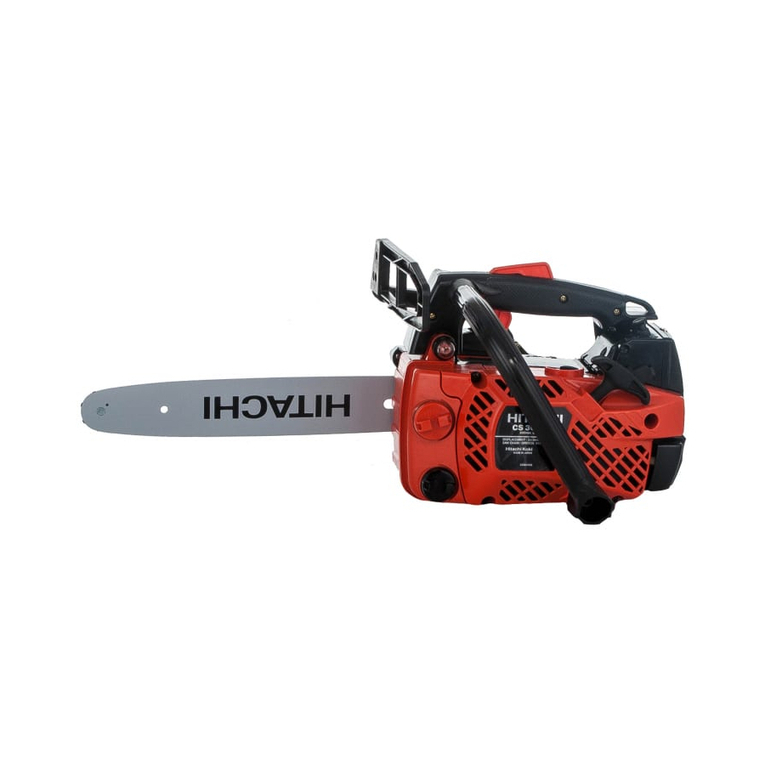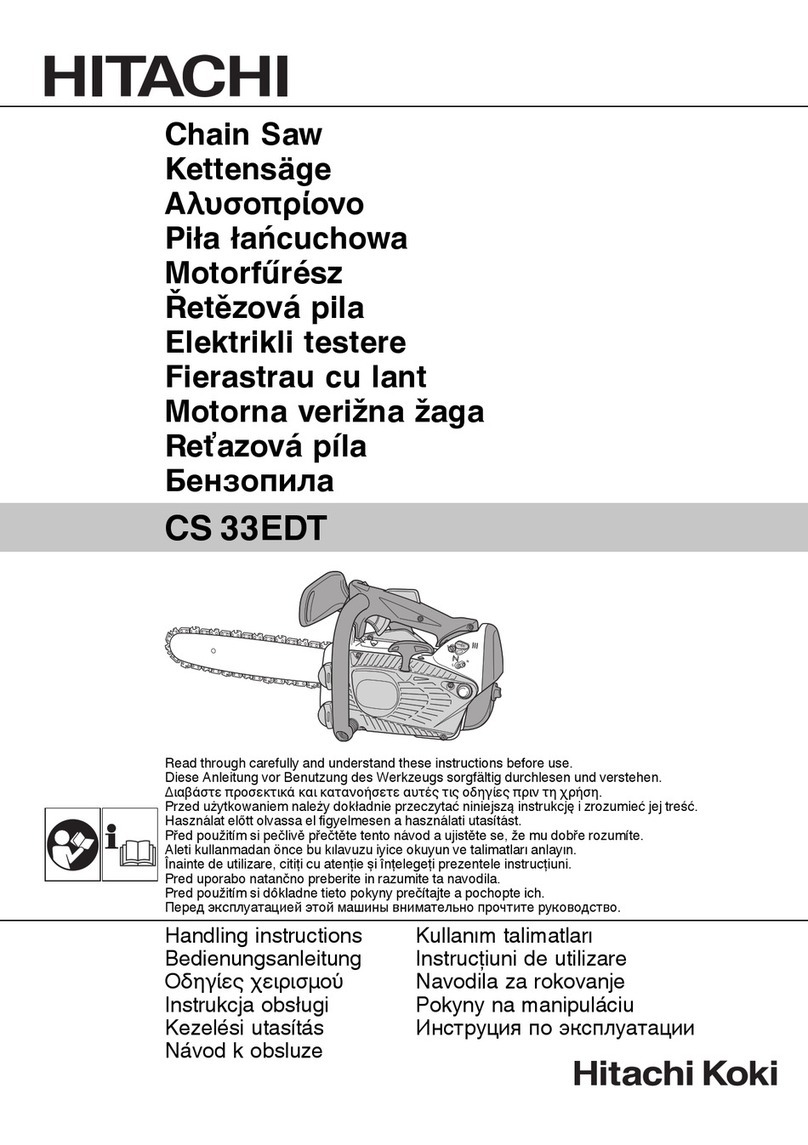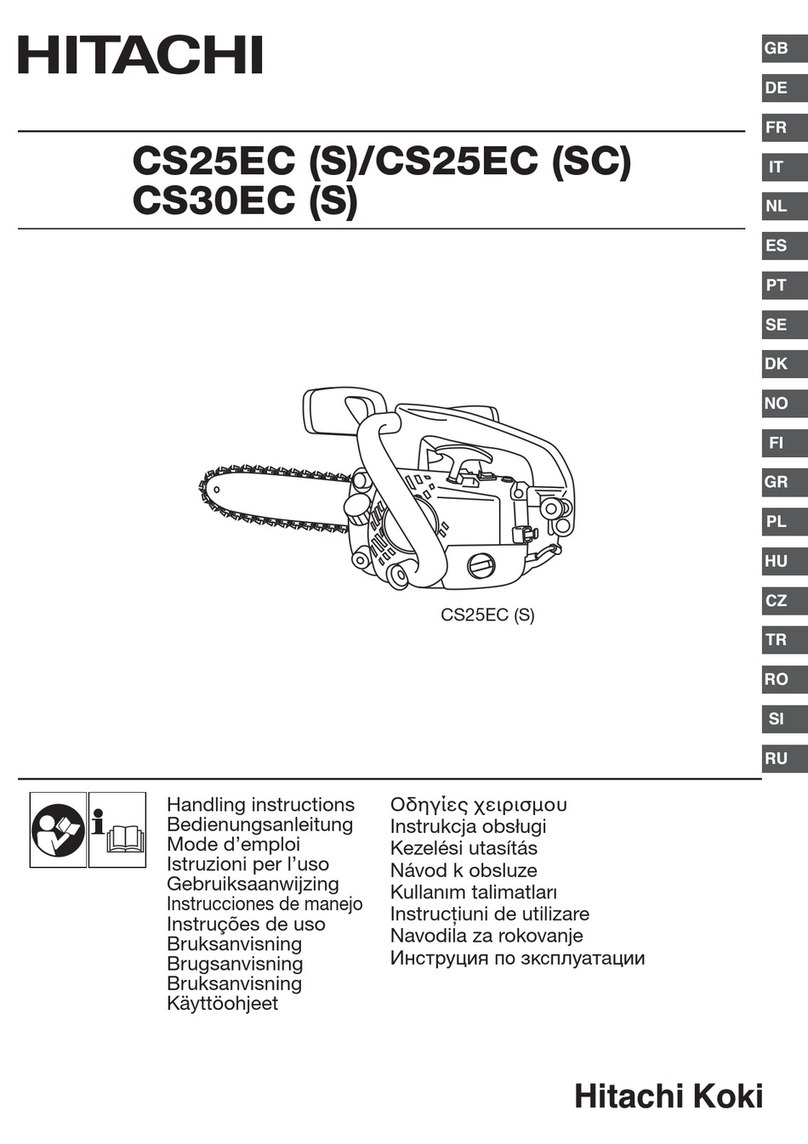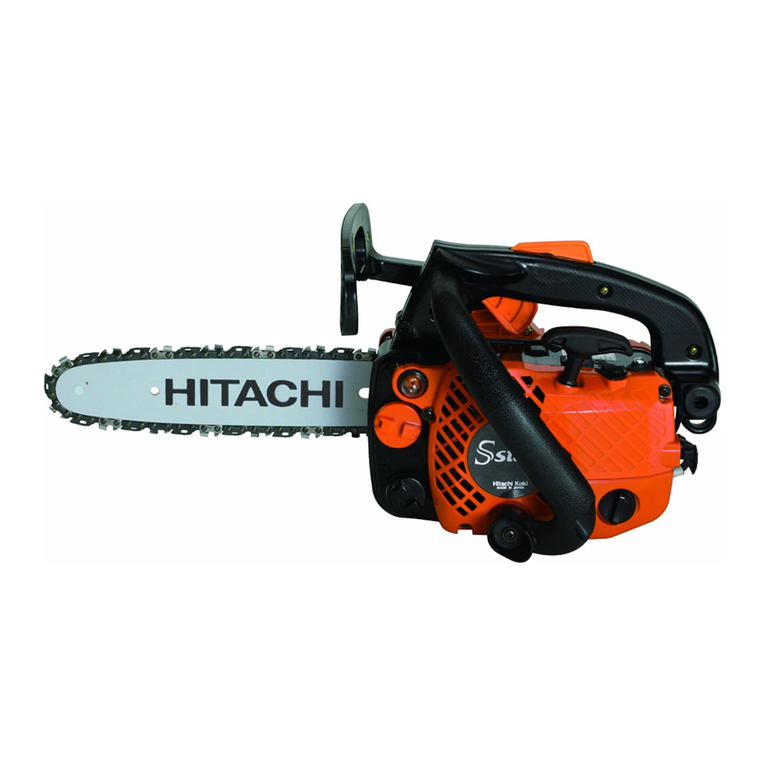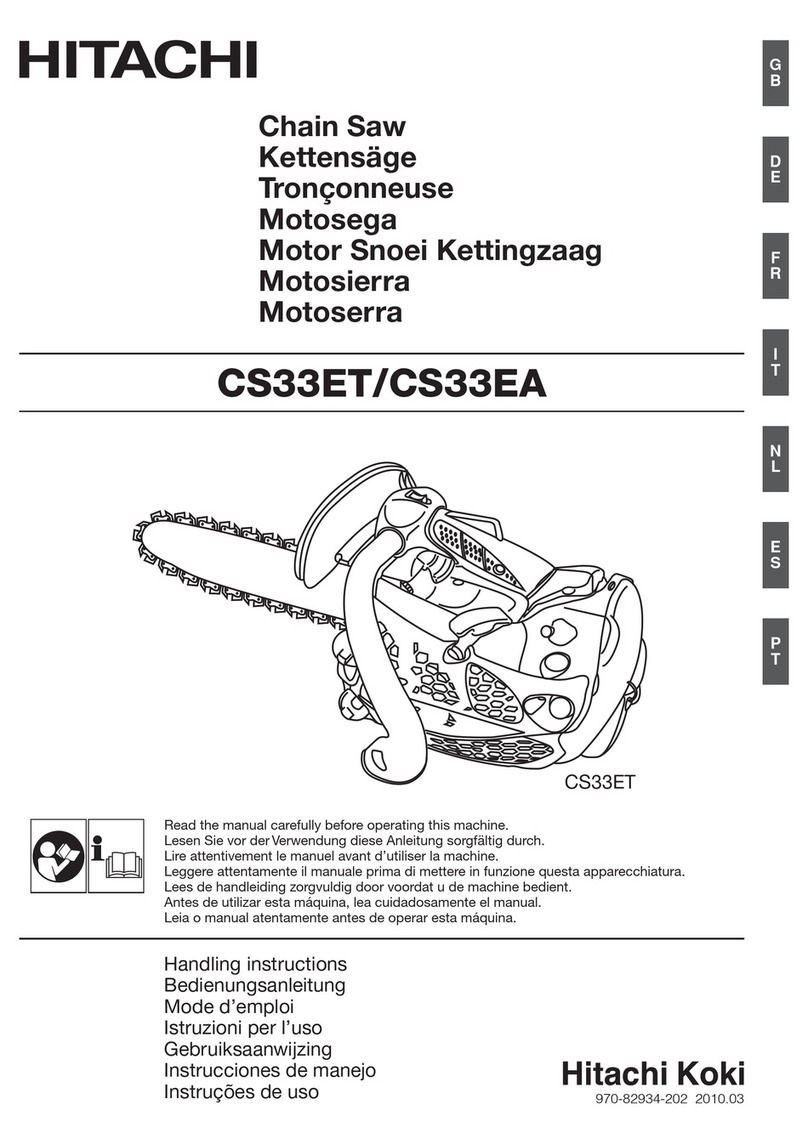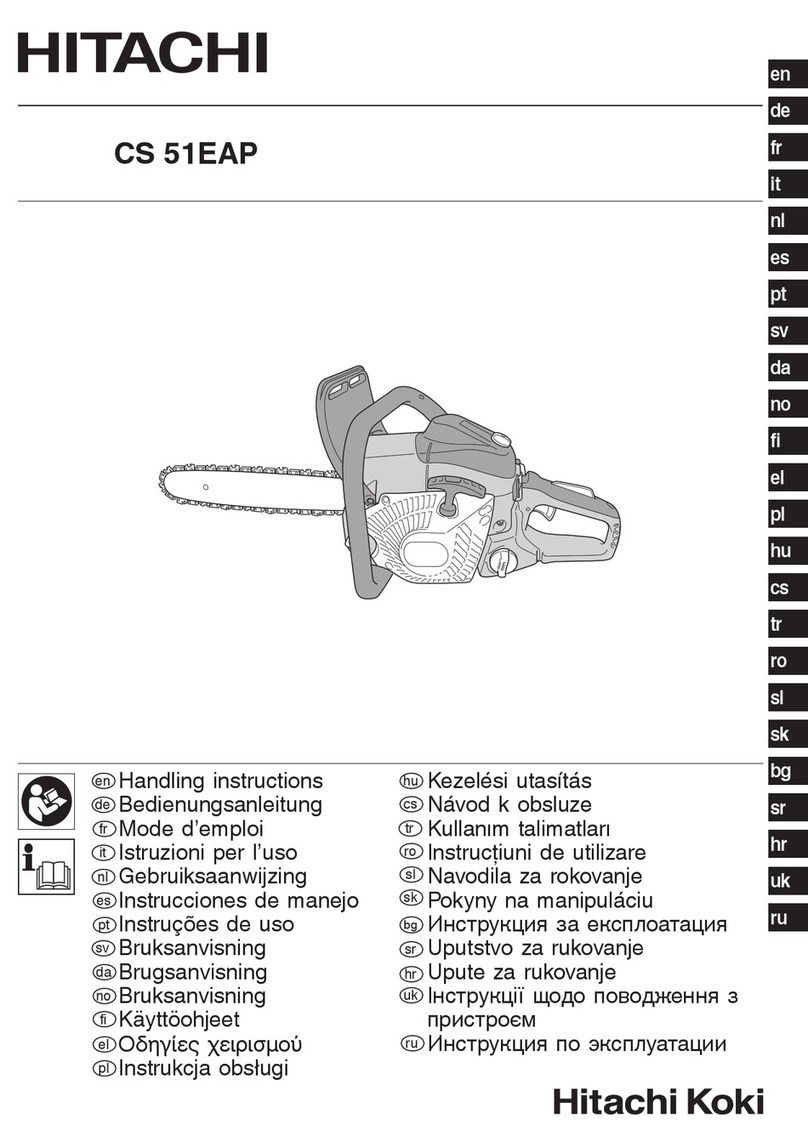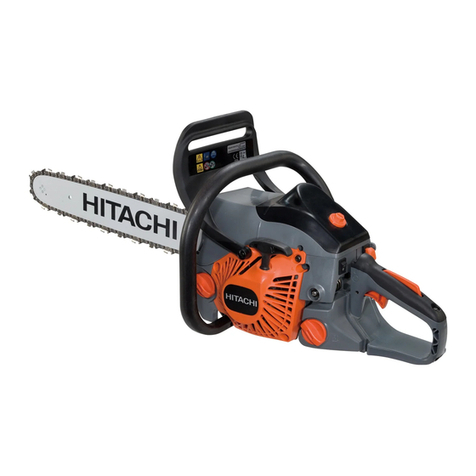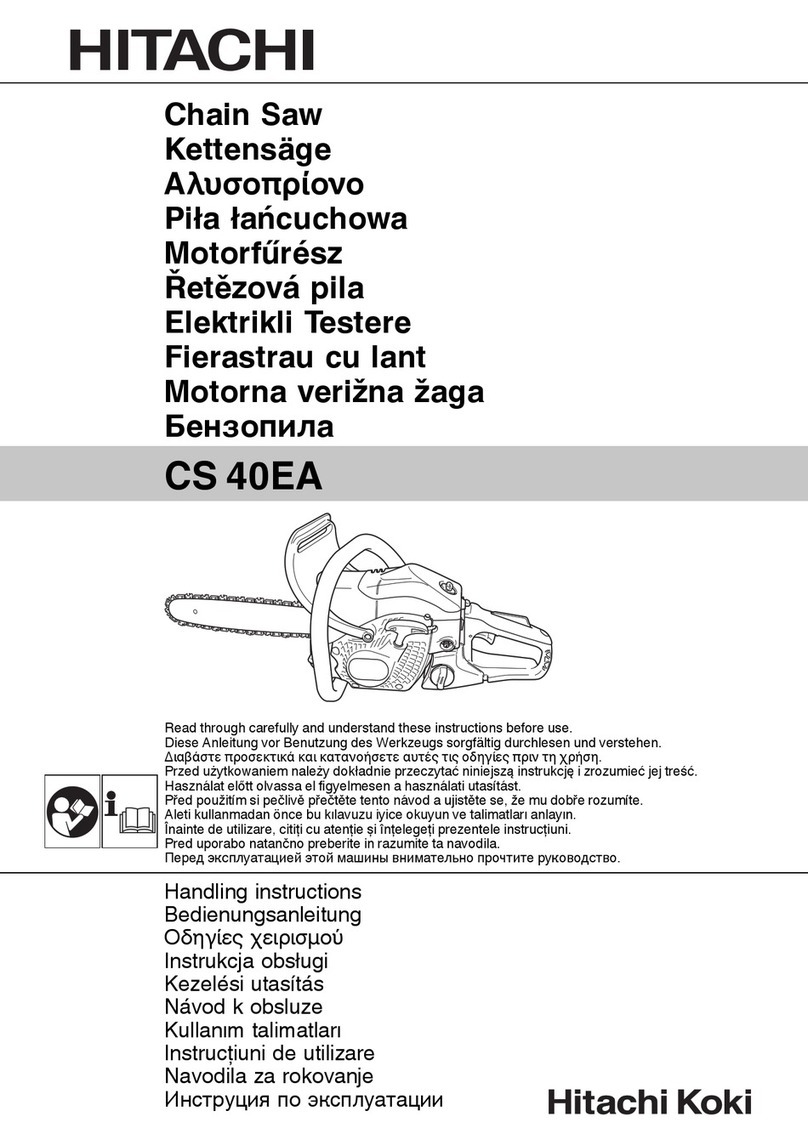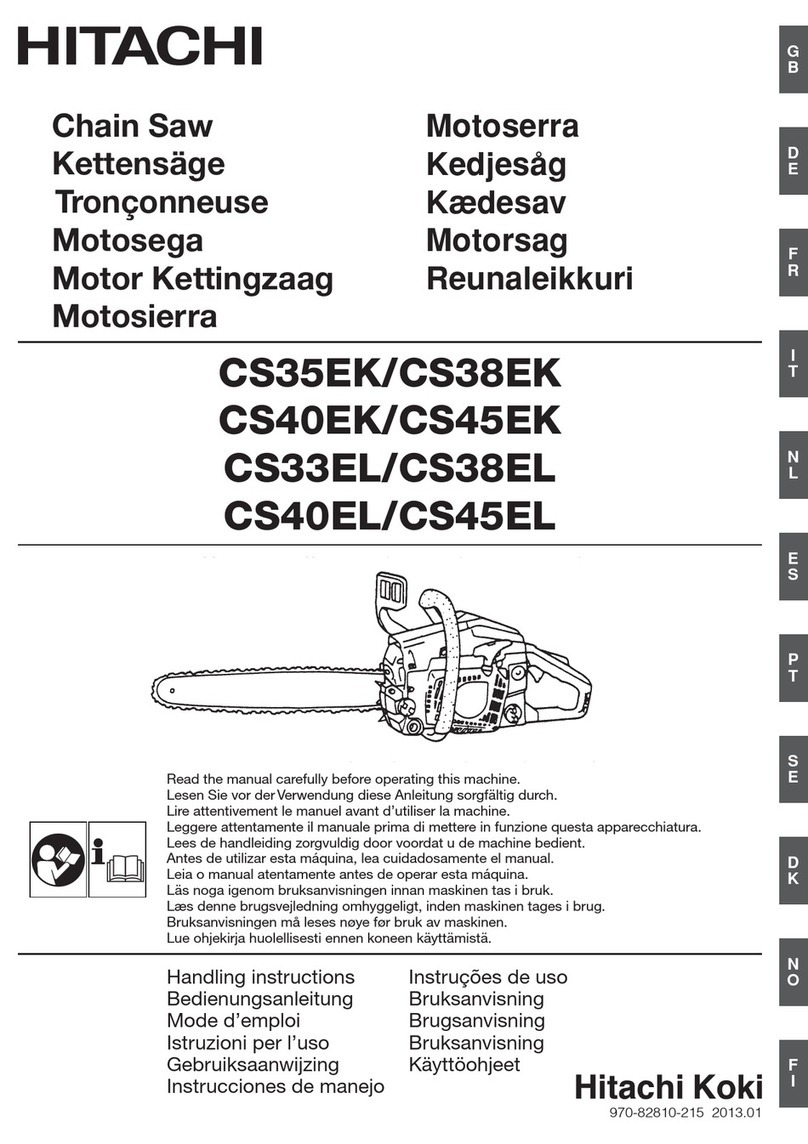
4
English
○Make sure the automatic oiler is working. Keep the oil tank fi lled
with clean oil. Never let chain run dry on the bar.
○All chain saw service, other than the items listed in the
operatorʼs/ ownerʼsmanual, should be performed by competent
chain-saw service personnel. (For example, if improper tools are
used to remove the fl ywheel or if an improper tool is used to hold
the fl ywheel in order to remove the clutch, structural damage
to the fl ywheel could occur and could subsequently cause the
fl ywheel to burst.)
WARNING
○Never modify the unit/machine in any way. Do not use your unit/
machine for any job except that for which it is intended.
○Never use chain saw without any safety equipment or that has
faulty safety equipment. It could result in serious personal injury.
○Using guide bar/chain other than recommended by the
manufacturer which are not approved, could result in ahigh risk
of personal accidents or injury.
Fuel safety
○Mix and pour fuel outdoors and where there are no sparks or
fl ames.
○Use acontainer approved for fuel.
○Do not smoke or allow smoking near fuel or the unit/machine or
while using the unit/machine.
○Wipe up all fuel spills before starting engine.
○Move at least 3maway from fueling site before starting engine.
○Stop engine and let it cool for afew minutes before removing fuel
tank cap.
○Empty the fuel tank before storing the unit/machine. It is
recommended that the fuel be emptied after each use. If fuel is
left in the tank, store so fuel will not leak.
○Store unit/machine and fuel in area where fuel vapors cannot
reach sparks or open fl ames from water heaters, electric motors
or switches, furnaces, etc.
WARNING
Fuel is easy to ignite or get explosion or inhale fumes, so that pay
special attention when handling or fi lling fuel.
Cutting safety
○Do not cut any material other than wood or wooden objects.
○For respiratory protection, wear an aerosol protection mask
when cutting the wood after insecticide has been applied.
○Keep others including children, animals, bystanders and helpers
outside the hazard zone. Stop the engine immediately if you are
approached.
○Hold the unit/machine fi rmly with the right hand on the rear
handle and the left hand on the front handle.
○Keep fi rm footing and balance. Do not over-reach.
○Keep all parts of your body away from the muffler and cutting
attachment when the engine is running.
○Keep Bar/Chain below waist level.
○Before felling atree, the operator must be accustomed to the
sawing techniques of the chain saw.
○Be sure to pre-plan asafe exit from afailing tree.
○While cutting, hold the unit/machine fi rmly with both hands with
thumb fi rmly locked around front handle, and stand with feet well
balanced and your body balanced.
○Stand to the side of the saw when cutting -never directly behind
it.
○Always keep the spiked bumper face to atree, because the
chain may suddenly be drawn into atree, if so equipped.
○When completing acut, be ready to hold up the units as it breaks
into clear, so it will not follow through and cut your legs, feet or
body, or contact an obstruction.
○Be alert against kickback (when saw kicks up and back at
operator). Never cut with the nose of the bar.
○When relocating to anew work area, be sure to shut offthe
machine and ensure that all cutting attachments are stopped.
○Never place the machine on the ground when running.
○Always ensure that the engine is shut offand any cutting
attachments have completely stopped before clearing debris or
removing grass from the cutting attachment.
○Always carry afi rst-aid kit when operating any power equipment.
○Never start or run the engine inside aclosed room or building
and/or near the infl ammable liquid. Breathing exhaust fumes
can kill.
Maintenance safety
○Maintain the unit/machine according to recommended
procedures.
○Disconnect the spark plug before performing maintenance
except for carburetor adjustments.
○Keep others away when making carburetor adjustments.
○Use only genuine HITACHI replacement parts as recommended
by the manufacturer.
CAUTION
Do not disassemble the recoil starter. You may get apossibility
of personal injury with recoil spring.
WARNING
Improper maintenance could result in serious engine damage or
in serious personal injury.
Transport and storage
○Carry the unit/machine by hand with the engine stopped and the
muffler away from your body.
○Allow the engine to cool, empty the fuel tank, and secure the
unit/machine before storing or transporting in avehicle.
○Empty the fuel tank before storing the unit/machine. It is
recommended that the fuel be emptied after each use. If fuel is
left in the tank, store so fuel will not leak.
○Store unit/machine out of the reach of children.
○Clean and maintain the unit carefully and store it in adry place.
○Make sure stop switch is offwhen transporting or storing.
○When transporting or storage, cover chain with guide bar cover.
If situations occur which are not covered in this manual, take care and
use common sense. Contact HITACHI dealer if you need assistance.
Pay special attention to statements preceded by the following words:
WARNING
Indicates astrong possibility of severe personal injury or loss of
life, if instructions are not followed.
CAUTION
Indicates apossibility of personal injury or equipment damage, if
instructions are not followed.
NOTE
Helpful information for correct function and use.
WARNING
KICKBACK DANGER (Fig. 1)
One of the most severe dangers when working with achain saw is
the possibility of kickback. Kickback may occur when the upper tip
of the guide bar touches an object, or when the wood closes in and
pinches the saw chain in the cut. Tip contact in some cases may
cause alightning fast reverse reaction, kicking the guide bar up and
back toward you. Pinching the saw chain along the top of the guide
bar may also push the guide bar rapidly back towards you. Either of
these reactions may cause you to lose control of the saw which could
result in serious personal injury. Even though your saw has safety
built into its design, you should not rely on these safety features
exclusively. Know where your bar tip is at all times. Kickback does
occur if you allow the kickback zone (1) of the bar to touch an object.
Do not use that area. Kickback from pinching is caused by acut
closing and pinching the upper side of the guide bar. Study your cut
and make sure it will open as you cut through. Maintain control when
the engine is running by always keeping afi rm grip on the saw with
your right hand on the rear handle, your left hand on the front handle
and your thumbs and fi ngers encircling the handles. Always hold the
saw with both hands during operation and cut at high engine speed.
Follow manufacturer's sharpening and maintenance instructions
for the saw chain. The lack of this maintenance may increase the
possibility of kickback.
1
Fig. 1
000BookCS51EAEng.indb4000BookCS51EAEng.indb4 2011/09/0416:26:452011/09/0416:26:45

